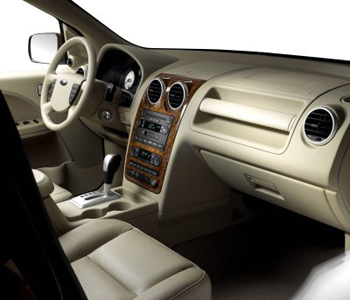Career job information for job seekers and find good employment job
By Mike Cervantes
Ford Motor Company has definitely been a major benefactor of the SUV boom of the ‘90s, its Explorer the top-selling sport ‘ute for most of the decade. The full-size Expedition and Lincoln Navigator models were no sales losers, either. Despite their good fortune with the truck-based SUVs of the past, Ford senses the winds of change that are starting to blow through the market. This is why Ford has proclaimed this the “Year of the Car” (see our Five Hundred article for more), and this is why they are readying what seems to be a direct competitor to their own Explorer. The Explorer’s position in the market is becoming vulnerable as people look for something easier to handle. Certainly the self-shredding Firestone tires and their related media scandal did nothing to help the Explorer’s image, as well.
Enter the Freestyle, a midsize, SUV-like wagon with three rows of seats and plenty of interior space. Yes, that’s the same basic formula that has made the Explorer popular, but the vehicles go their separate ways beyond that. The Explorer generally follows the body-on-frame SUV idiom: Tall, Tippy, and Truck-y. They are the dreaded three Ts that are slowly turning many consumers away. The Freestyle is the opposite of that in just about every way. It’s lower to the ground, eliminating the first two Ts; and the platform underpinning it is a version of the one that is underneath the Volvo S80 and Ford Five Hundred sedans. Yes, there is the possibility that the Freestyle could steal buyers away from brother Explorer. That is okay, as Ford would rather keep them in the Blue Oval family rather than see them buy other crossovers like the Chrysler Pacifica, Nissan Murano, Honda Pilot, or Toyota Highlander.
As mentioned earlier, the Freestyle is based on a platform originally designed by Volvo and adapted by Ford for use here and the Ford Five Hundred/Mercury Montego twin sedans. It is, essentially a FWD car platform rather than a body-on-frame RWD truck platform. It features a fully independent suspension (McPherson struts, coil-over rear shocks) and best in class torsional rigidity. A Halidex-style AWD system will be optional. The engine is Ford’s “Duratec 30” 3.0L V6 with 203hp@5750 rpm and 207ft-lbs@4500 rpm. Like its sedan counterpart, the Five Hundred, there is some concern as to whether this will be enough to propel the 4112-pound Freestyle at a rate comparable to some of the competition, like the 240hp Murano. Following Nissan’s lead, Ford will offer a continuously variable transmission – developed in its partnership with ZF. CVTs are often lauded for their ability to help reduce emissions and improve fuel economy without sacrificing performance, though they are only available in a select few vehicles in America. Showing its true car-based roots, the Freestyle can only tow 2000 lbs when properly equipped.
 |
| Courtesy: Ford Motor Company |
Storage space is crucial in a family vehicle such as the Freestyle, and Ford does not disappoint. As such, there’s a bin atop the instrument panel for front seat passengers, as well as space in the optional overhead console for items like sunglasses and garage-door openers. The bin under the center armrest of the first row offers a power point for cell phone or laptop chargers and includes a small cutout so that the cord does not get pinched when the bin lid is closed. Smart.
Overall aesthetics, inside and out, are clean and contemporary. The exterior features a squared off face and greenhouse design seen on other Ford SUVs like the Explorer and Expedition. The interior is a continued evolution of the themes presented in the latest Expedition and F-150 truck. It is, arguably, one of the highest-quality Ford interiors to date, at least in looks. While some have deemed the Freestyle the “Stylefree,” it wouldn’t be any surprise to see buyers flock to the safe choice.
 |
| Courtesy: Ford Motor Company |
Finds more jobs employment
0 comments:
Post a Comment